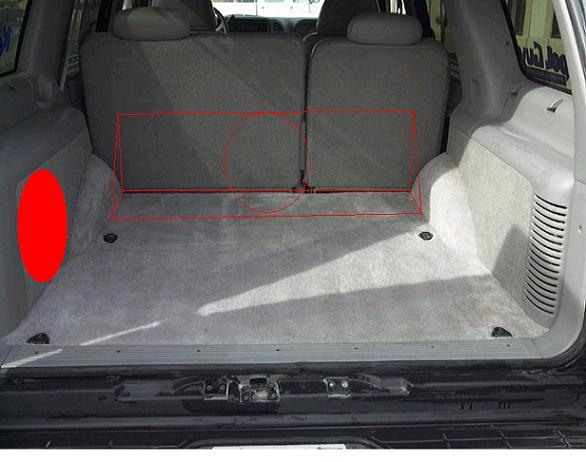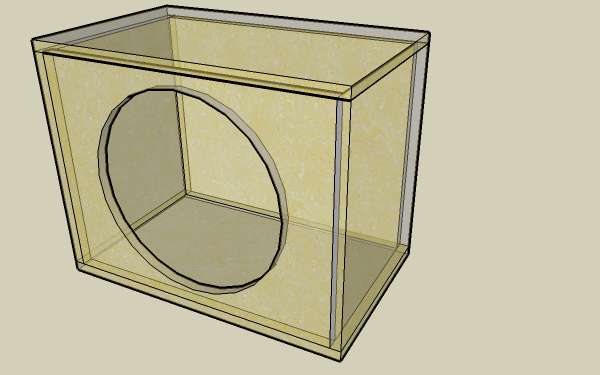15" Adire Brahma Box help
|
Silver Member Username: BigharvPost Number: 186 Registered: Jun-07 | I'm gonna be installing a brahma into my tahoe and i want to do it in the least amount of space. I would consider sealed or ported and even IB if possible. The space in the back is huge but i would like for the box to take as little space as possible. I'm only gonna be delivering around 800 watts to it max so i dont think small compact enclosure will work very well. |
|
Gold Member Username: BlainewPost Number: 2519 Registered: Nov-05 | 1.5-2.0 cubic feet will work well, for a sealed box |
|
Silver Member Username: BigharvPost Number: 187 Registered: Jun-07 | do you think i should do it in like that wedge shape and snug it up against the seat? i want to save as much space as I can for hauling my $hit back and forth to school. rectangular box's arent the best space saver. |
|
Silver Member Username: BigharvPost Number: 189 Registered: Jun-07 |  triangle wedge shape, the only problem is the mounting depth would be huge. Would that circle on the left be a good IB spot? |
|
Gold Member Username: BlainewPost Number: 2520 Registered: Nov-05 | i am not a fan of IB, you can get better SQ sealed make the box any shape you want...but between 1.5 and 2 cubic feet. the smaller the box, the tighter the bass... |
|
Silver Member Username: Mike11202Sewell, NJ US Post Number: 880 Registered: Nov-06 | better get one of these to be safe http://www.partsexpress.com/pe/showdetl.cfm?&Partnumber=260-444 |
|
Gold Member Username: InsearchofbassPost Number: 5942 Registered: Jun-04 | go 1.5 cubic feet net sealed stuffed check this chart for fiberfill amount to get to 2.00 cf net http://web.archive.org/web/20020808224043/integra.cyberglobe.net/caraudio/resour ces/fiberfill/ |
|
Silver Member Username: BigharvPost Number: 190 Registered: Jun-07 | cant get to that link from work, i could go as small as 1.5 cu ft and stuffing it will make it seem like a larger volume? |
|
Gold Member Username: InsearchofbassPost Number: 5948 Registered: Jun-04 | yes....link works for me but did have fits earlier FILL 'ER UP -------------------------------------------------------------------------------- Make a small box act like a larger one with polyester fiberfill By TOM NOUSAINE The word "FIBER" is turning up in a lot of hip conversations these days � you know, the ones that take place in art galleries, bistros, and install bays. In the galleries, they're talking about the fiber-optic conduits through which compressed digital audio and video will travel when the Intergalactic Superhighway concludes the long and winding road to our homes. In the bistros, they're talking about the colon-scrubbing glory of fiber-rich delicacies like oatmeal quesadillas and bran flan. But, to us � the few, the proud, the mighty Box Builders � fiber means dacron-polyester fiberfill, that magic and powerful ingredient that helps deliver maximum bass from a tiny space. SEALED ENCLOSURE 1.4-ft³ Box Stuffing Density (lb/ft³ ) System Resonance (Fsb) Effective Size Percentage Gain 0 56.6 1.4 -- 0.70 53.0 1.6 14% 0.75 52.7 1.7 21% 1.50 51.7 1.8 29% 1.75 50.8 1.9 36% 2.60 50.4 1.6 14% 3.10 52.6 1.2 -14% It's no secret that you can use fiber- fill to make low-end magic; clever installers have been using it for years Take two boxes of the same size and type, insert the same woofer into each one, and stuff one with some fiber-fill � the one with the stuffing should kick out lower bass. In simple terms, it works like this: The fiberfill fools the woofer into thinking that it's in a larger box (one with more air, or internal volume, in it). than it really is. And, in general, the larger the box, the lower the bass you can get out of it. Fiberfill stuffing is a popular alternative for people who can't or don't want to allot a lot of space for a subwoofer box. A compound or Isobarik configuration, which pairs two woofers in one box, is another popular option, though it has some considerable downsides: For one thing, you have to buy two woofers. There is also a theoretical sensitivity loss (on the order of 6 dB) because you end up with twice the cone mass, though you can cut your losses � losing only a few dB SPL � by running a pair of the drivers in parallel. SEALED ENCLOSURE 5.1-ft³ Box Stuffing Density (lb/ft³ ) System Resonance (Fsb) Effective Size Percentage Gain 0 42.0 5.1 -- 0.25 42.0 5.1 0% 0.50 41.2 5.8 14% 0.75 40.3 6.2 22% 1.00 39.4 6.5 27% 1.25 38.6 6.5 27% 1.50 40.2 5.6 9% The particulars of fiber stuffing are pretty interesting: The air inside your enclosure actually heats up as your woofer moves, making the air stiffer. (I'm absolutely serious.) When the enclosure is stuffed with fiber, the fibers wiggle, dissipating some of the heat and making the system work as though the box were larger. Theoretically, your woofer/box bass system can act like a system that's a maximum of 40 percent larger when you've latched onto the right stuffing recipe � in other words, if you have an enclosure that offers 1 cubic foot (1 ft³ ) of internal volume, in a perfect world a good stuffing job will make it perform like an enclosure that offers 1.4 cubic feet of internal volume. There are three types of stuffing that are commonly used for this purpose: fiberglass insulation, long-fiber wool, and polyester fiberfill. Fiberfill is the best choice because it doesn't come loose and fly around and irritate your skin or lungs like fiberglass, it works as well as either of the others, it's a lot cheaper than wool, and moths hate it. I recently bought five 20-ounce bags of it at $1.99 a pop (a total of 6.26 pounds for $9.95) at Minnesota Fabrics; that turns out to be about $1.60 a pound. You should be able to find some at any fabric store or in the bedding section at friendly stores like K-Mart or Home Depot. To evaluate the effectiveness of box stuffing, I used an MLSSA analyzer to measure the impedance of three enclosures � 5.l-cubic-foot sealed, 1.4-cubic-foot sealed, and 1.4-cubic-foot ported (the port measured 3 inches in diameter and 6 inches in length) � with various densities of stuffing. For the sealed boxes, I was able to determine the effective box size � as enhanced by the stuffing � using the system's resonant-frequency and Qes values. For the ported box, I compared the tuned frequency of the empty enclosure to the tuned frequency of the stuffed enclosure, using the Speak for Windows computer program; this enabled me to find the effective box size that fit the actual resonant frequency I'd measured. PORTED ENCLOSURE 1.4-ft³ Box Stuffing Density (lb/ft³ ) System Resonance (Fsb) Effective Size Percentage Gain 0 42.0 1.4 -- 0.40 39.1 1.6 14% 0.85 37.2 1.8 29% 1.25 35.2 1.9 36% 1.40 34.2 2.0 43% 1.75 35.2 1.9 36% In each case, the news was good � make that very good. With all three boxes, I enjoyed roughly 25 to 35 percent of "space gain" by using stuffing at a rate of 1 to 1.75 pounds per cubic foot of internal volume. When making system performance predictions, be aware that the Qes figure � and, therefore, the Qts figure � of the sealed boxes dropped. And with the ported box, the peak of the impedance curve on the lower side of the tuned frequency became heavily damped below the box's point of resonance. I also found that there is such a thing as too much of a good thing: System resonance (Fsb) rises again, beginning with densities of around 1.5 pounds of stuffing per cubic foot of box volume; this happens because the fibers are jammed so tightly together that they stop wiggling and, consequently, stop dissipating heat. I also found that stuffing gets less effective as box size increases. The morale: The bigger your box is, the harder it is to fool your woofer. A few rules of thumb: Stuff small enclosures � those with up to about 3 cubic feet of internal volume or less � with 1.5 pounds of fiberfill for each cubic foot of internal volume and you should get about a 30-percent increase in box volume without seriously affecting other performance variables. For larger enclosures, add stuffing at a rate of approximately 1 pound per cubic foot and you should get a virtual-space boost of about 25 percent. One thing's certain: You'll impress the heck out of your friends at the art gallery and bistro. -------------------------------------------------------------------------------- CAR STEREO REVIEW March/April 1995 Hachette Flilipacchi Magazines Box Builder, Page 100 -------------------------------------------------------------------------------- HONDA / ACURA INTEGRA PAGE CAR AUDIO & ALARM SECTION Maintained by Stephane Bismuth |
|
Gold Member Username: InsearchofbassPost Number: 5949 Registered: Jun-04 | do 1.75 pounds per cubic foot at 1.5 cubic feet net sealed and you should be at 2.00 cubic feet net |
|
Silver Member Username: BigharvPost Number: 191 Registered: Jun-07 | good idea, does anyone know the mounting depth of a 15" brahma |
|
Gold Member Username: InsearchofbassPost Number: 5954 Registered: Jun-04 | 8.25 inches allow plenty of depth for the fill http://www.acoustic-visions.com/~acoustic/products/subwoofer_drivers/adire_brahm a/brahmaownersmanual.pdf |
|
Silver Member Username: BigharvPost Number: 192 Registered: Jun-07 | its an MK 1 if that makes any difference |
|
Silver Member Username: BigharvPost Number: 193 Registered: Jun-07 |  Internal: 20x16x12 2.2222 cu ft and ill probably add 2 pounds or so of polyester assuming the displacement of the sub will bring it closer to 2.0 cu ft. the polyster should give it around a 30-35% virtual increase in box volume bringing it closer to 2.5-2.7 cu ft. |
|
Gold Member Username: InsearchofbassPost Number: 5955 Registered: Jun-04 | my recommendation was assuming you wanted 2 cubic feet net out of a 1.5 cubic feet box net |
|
Gold Member Username: InsearchofbassPost Number: 5956 Registered: Jun-04 | and id bet 2 pounds will give you a 10 percent increase in that box assuming youll be at 2 cubic feet net |
|
Gold Member Username: InsearchofbassPost Number: 5957 Registered: Jun-04 | well maybe a little more |
|
Silver Member Username: BigharvPost Number: 194 Registered: Jun-07 | thanks, but i figured i would go ahead and make it a little bit bigger, i can always just take it out if i need the extra room. still 2 cu ft is pretty small and if i can essentially get 2.5 cu ft out of it, im happy with that. |
|
Gold Member Username: InsearchofbassPost Number: 5958 Registered: Jun-04 | yeah that will be close to what you were aiming for.....looks good |
|
Silver Member Username: BigharvPost Number: 195 Registered: Jun-07 | well maybe ill do 3 pounds of polyester |
Main Forums
Today's Posts- Home Audio Forum
- Home Video Forum
- Home Theater Forum
- Car Audio Forum
- Accessories Forum
- All Forum Topics